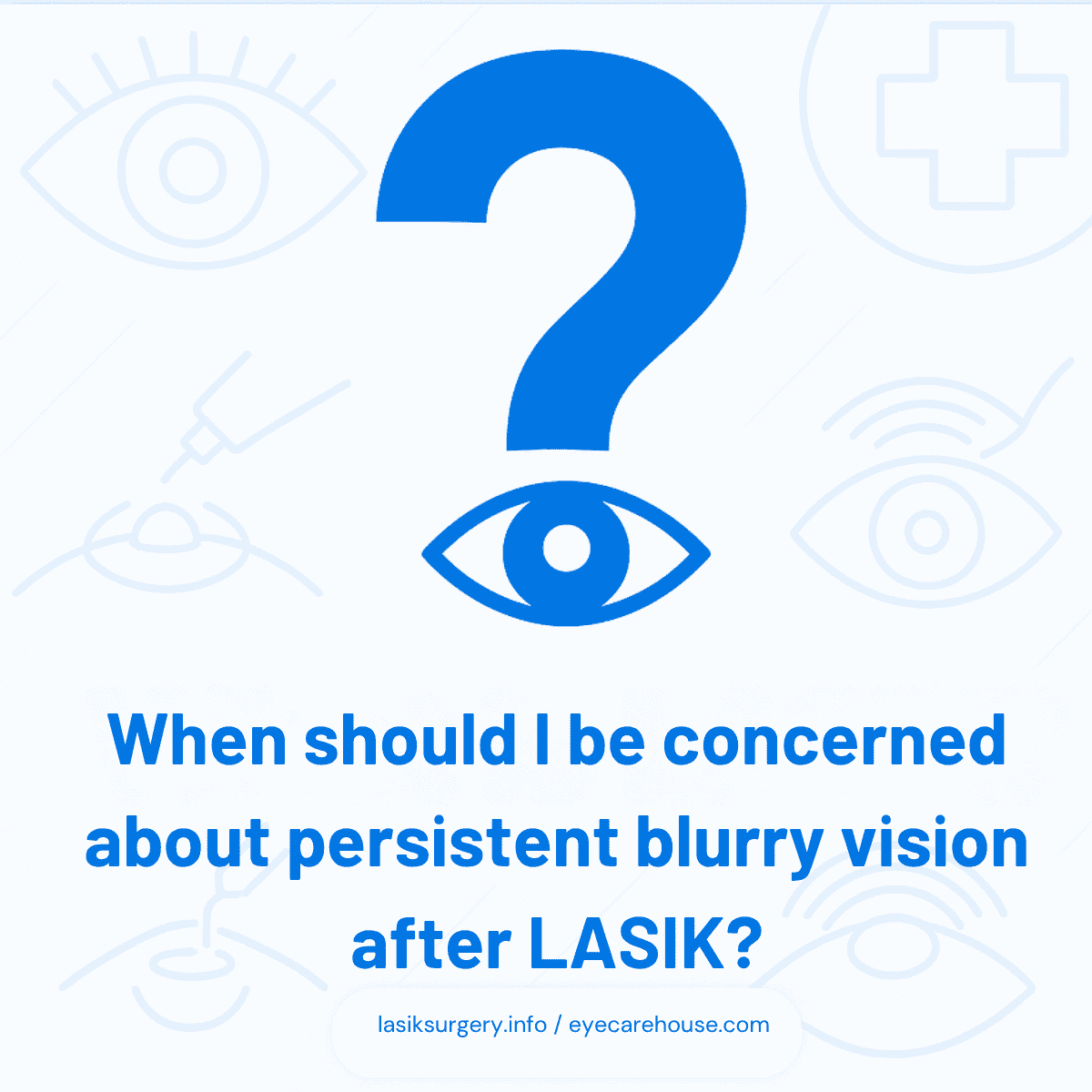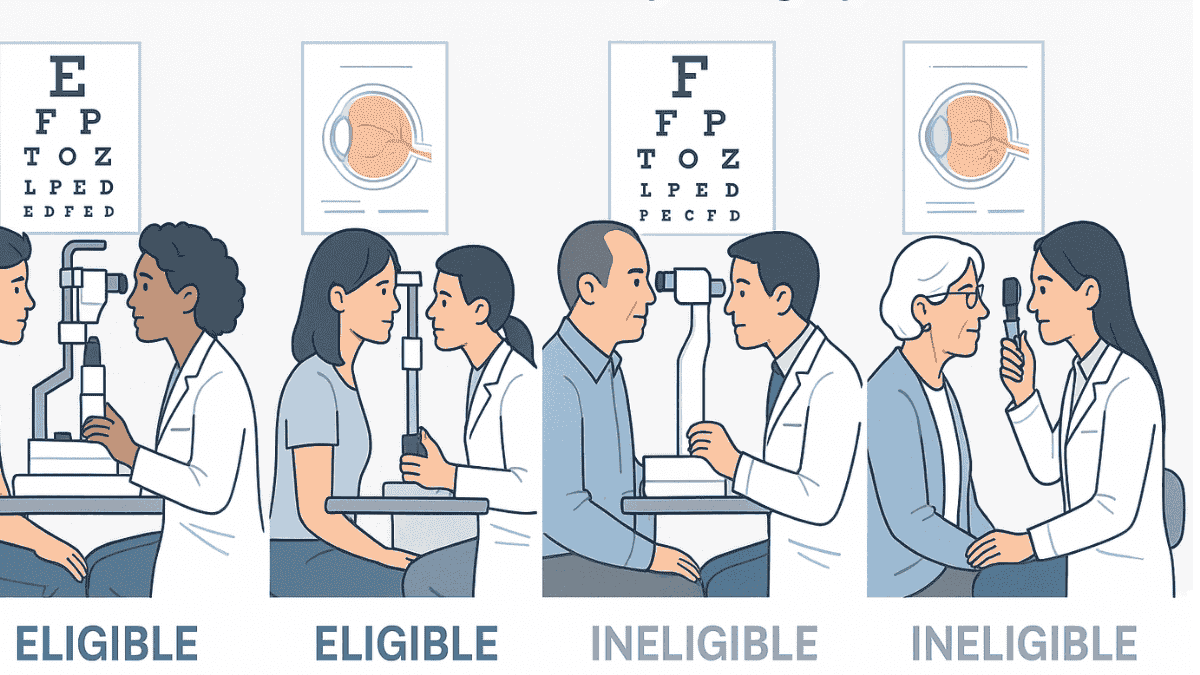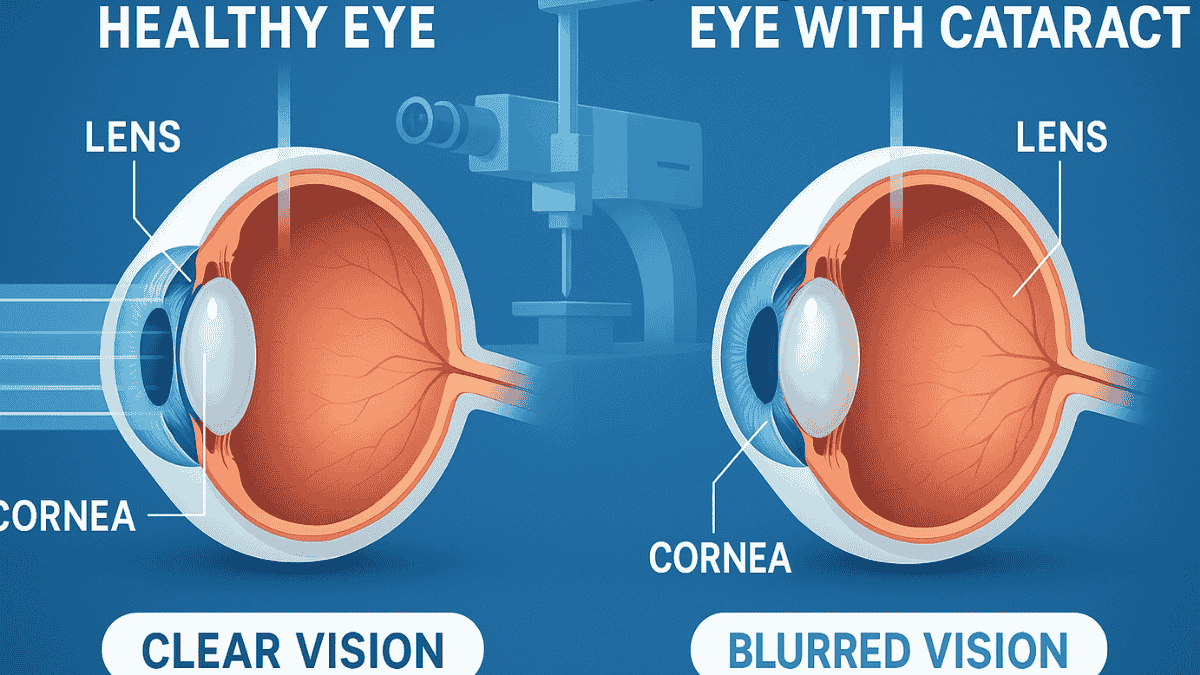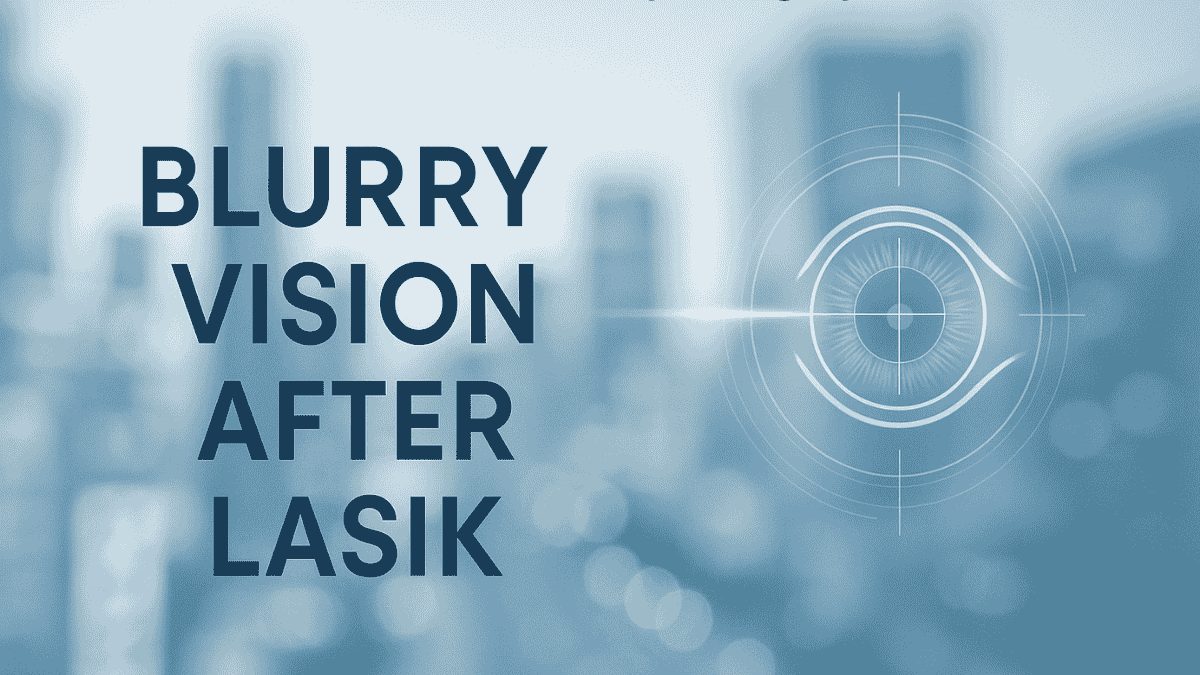
Blurry vision after LASIK can be frustrating — especially when you expected sharp, clear sight right away. It’s completely normal to feel concerned if your vision still seems hazy or inconsistent days or even weeks after your procedure.
But the good news is: for many patients, this is simply part of the natural healing process. Your eyes are adjusting, your cornea is recovering, and your tear film may be temporarily unstable — all of which can affect how clearly you see.
In this article, we’ll walk you through what kind of blurriness is expected, how long it usually lasts, and when it might be a sign to check in with your eye doctor.
Table of Contents
The Normal LASIK Recovery Timeline
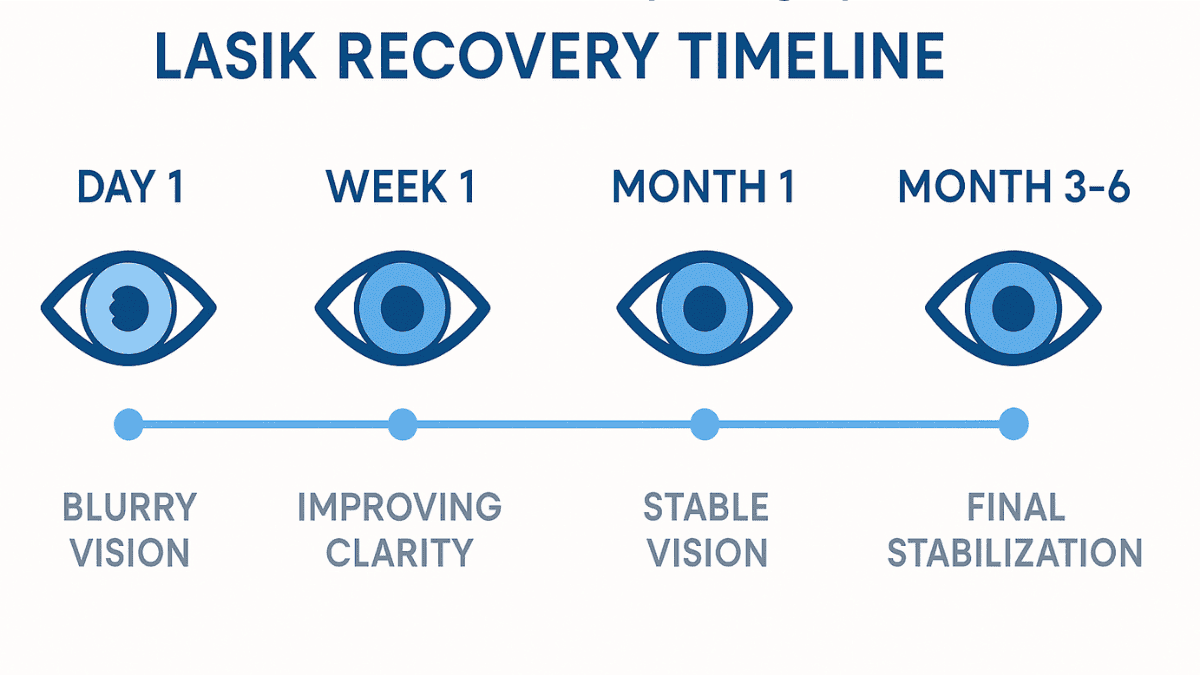
Your vision will likely fluctuate as your eyes heal from the laser eye surgery. It’s a gradual process, and patience is essential during the LASIK surgery recovery period. Here’s a general guide to what you can typically expect regarding your vision normal expectations:
| Time After Surgery | Expected Vision Quality |
|---|---|
| Day 1 | Blurry, hazy vision; potential for mild discomfort or light sensitivity. Some patients report seeing halos or glare. |
| Week 1 | Improving clarity, but still some blurriness, especially for close objects or in dim lighting. Dry eye symptoms may be more noticeable. |
| Month 1 | Significantly clearer vision for most; minor fluctuations are possible as the tear film stabilizes and healing continues. Distance vision usually improves considerably. |
| Month 3 | Stable vision for most patients; any residual blurriness should be minimal. This is often when final visual acuity is assessed. |
| Month 3-6 | Vision continues to stabilize. For some, subtle improvements may still occur. |
Remember, everyone’s healing process differs. Some people achieve clear vision within days of their eye surgery, while others may take several weeks or even a few months for their vision to fully sharpen. Factors like the degree of refractive error corrected and individual healing responses play a role.
Common Causes of Blurry Vision After LASIK
Several factors can contribute to blurry vision during your recovery from this type of refractive surgery. Understanding these can help manage expectations during the healing process.
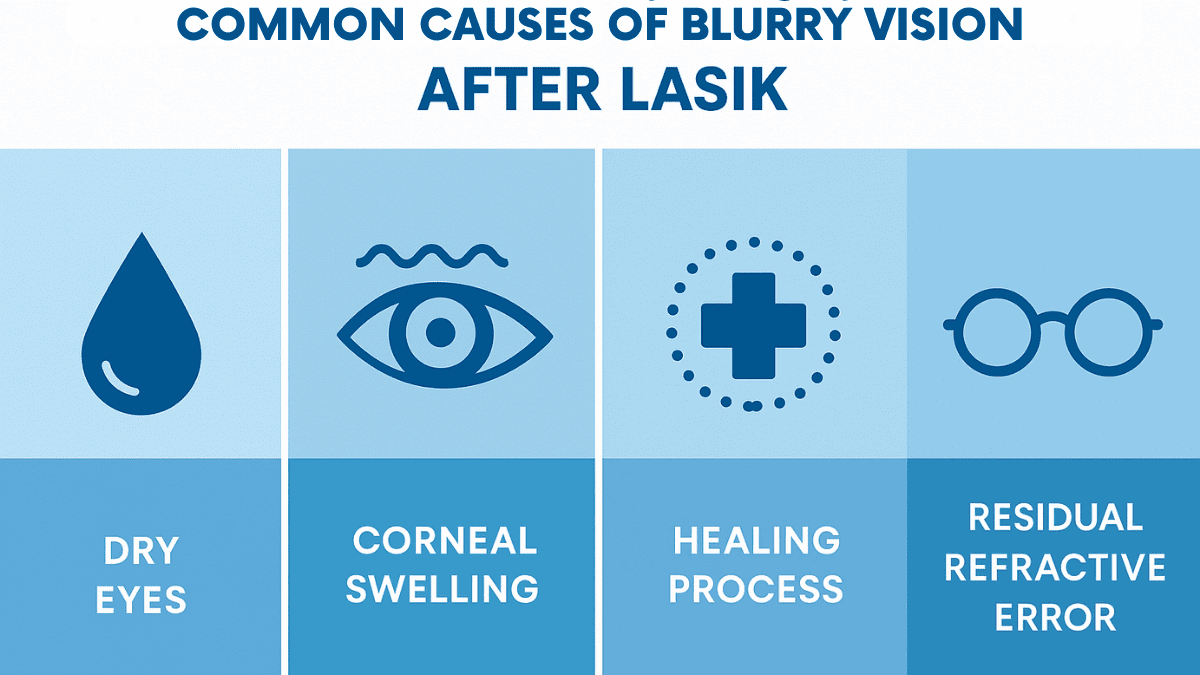
1. Dry Eyes
LASIK can temporarily decrease tear production, leading to dry eyes, a very common post-operative symptom. This dryness is a primary cause of fluctuating vision and blurriness, sometimes referred to as dry eye syndrome. Your eye doctor will likely recommend artificial tears frequently to keep the eye surface lubricated and improve comfort.
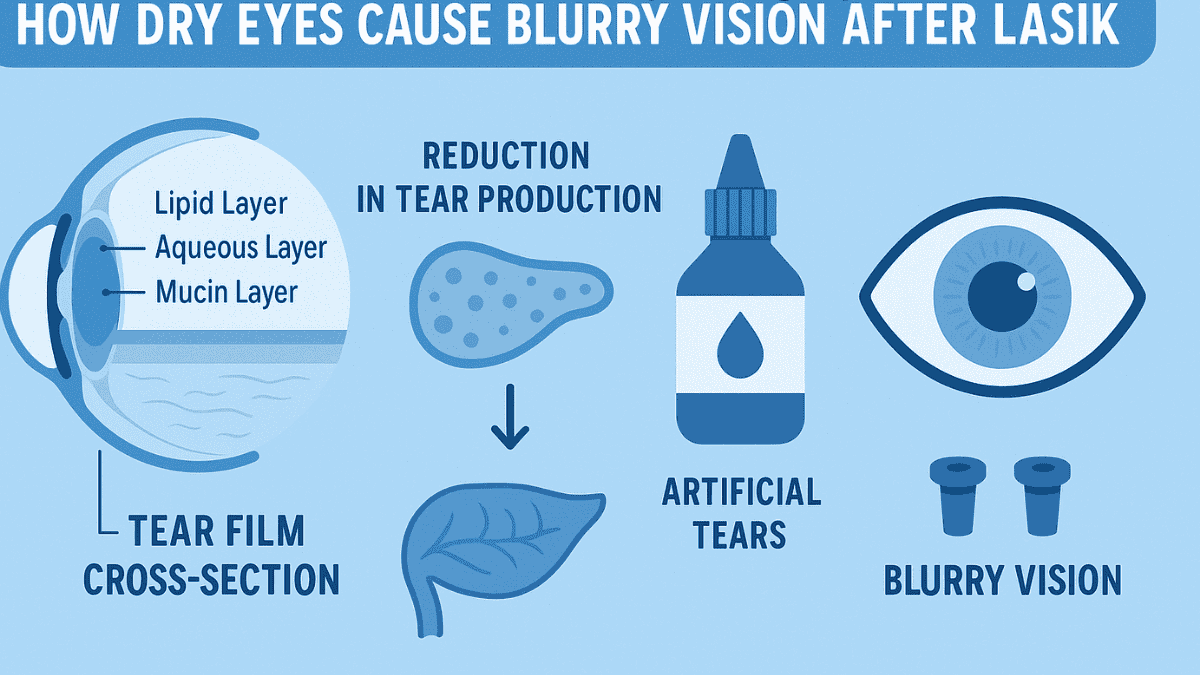
The tear film is crucial for clear, stable vision, and its disruption can directly lead to blurry vision. In some cases, if over-the-counter eye drops are insufficient, your doctor might suggest punctal plugs to help retain tears on the eye’s surface. Proper management of dry eyes is vital for optimal vision outcomes after laser vision correction.
Related Article
Managing Dry Eye Syndrome: Causes and Treatments2. Corneal Swelling and Inflammation
Your cornea, the outer layer of the eye that was reshaped by the femtosecond laser or excimer laser, may swell slightly after surgery. This inflammation is a natural response to the LASIK procedure and can affect your vision clarity. This corneal edema usually subsides within the first week or two as the eye heals.
Anti-inflammatory eye drops prescribed by your surgeon help manage this swelling. It’s important to use these drops as directed to minimize blurriness caused by inflammation.
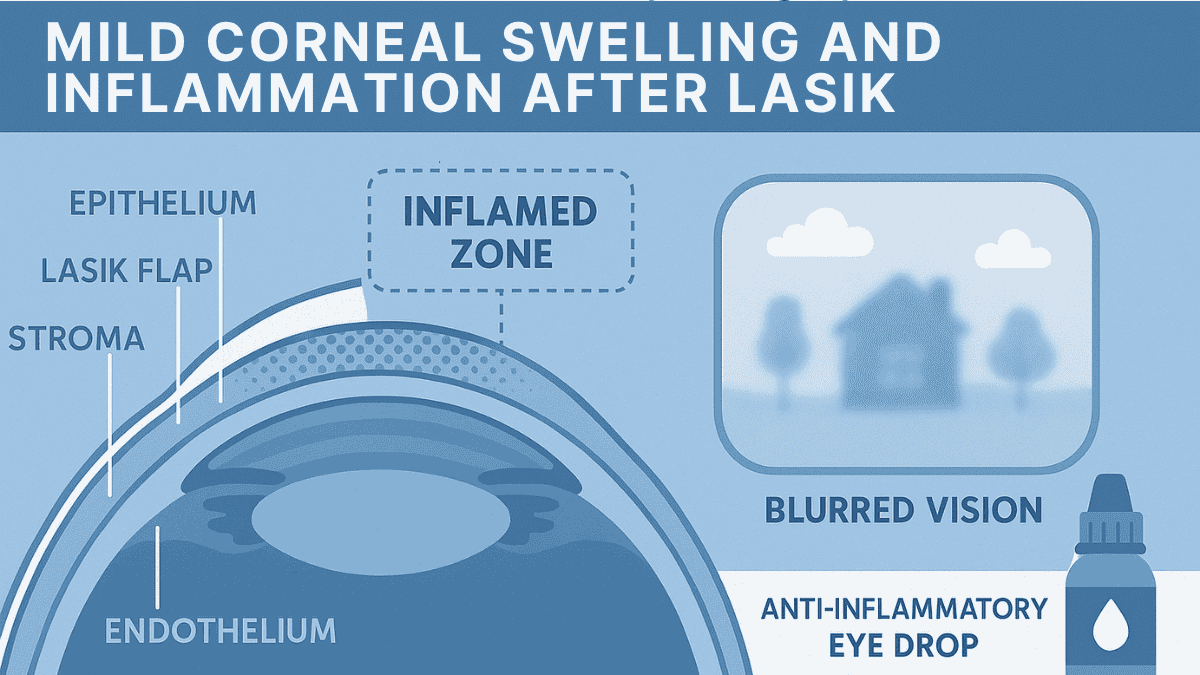
3. The Natural Healing Process
As your cornea heals and adapts to its new shape, your vision may fluctuate. This is a normal part of the healing process and should stabilize over time. The epithelial cells on the corneal surface regenerate, and the underlying stromal tissue remodels, all contributing to the final visual outcome.
Small amounts of residual refractive error, such as slight myopia post-operatively or astigmatism, can also contribute to blurriness. These often resolve or improve as healing progresses, but sometimes an additional surgery or enhancement may be considered later if significant.
4. Residual Refractive Error
Sometimes, the initial laser eye surgery might result in a slight undercorrection or overcorrection of your vision. This residual refractive error means your eye isn’t perfectly focused, causing blurry vision. Often, these are minor and may not require further intervention, or they may be addressed after the eye has fully healed.
If you were significantly hyperopic pre-operatively, the healing pattern might differ slightly from those with myopia. Your eye doctor will monitor this closely during follow-up visits.
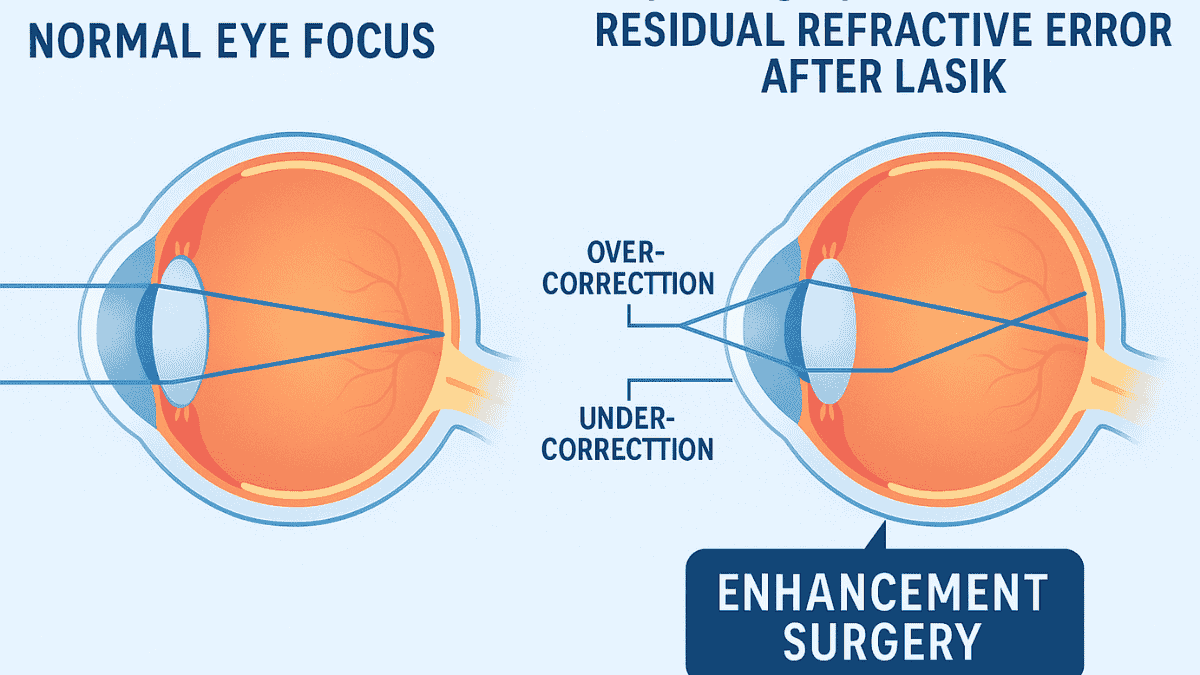
When to Be Concerned About Blurry Vision
While some blurriness is expected after laser eye surgery, certain symptoms warrant a prompt call to your eye doctor. Early detection of potential issues is important for maintaining good eye health. Do not hesitate to seek medical attention if you experience any of the following:
- Severe or worsening pain in the eye.
- Sudden, significant decrease in vision.
- Colored discharge (e.g., yellow or green) from your eye, which could indicate an infection.
- Increased redness or swelling of the eyelid.
- Blurriness that persists or worsens significantly beyond the first few weeks, or new blurriness that develops after a period of clear vision.
- Floaters or flashes of light that are new or significantly increased.
- Persistent blurry vision beyond 3-6 months without improvement.
These symptoms could indicate complications such as infection, significant inflammation, corneal haze, issues with the corneal flap (if traditional LASIK was performed), or even problems with the retina that’s responsible for central vision. While rare, conditions like macular degeneration affect central vision but are unrelated to LASIK; however, any sudden vision change warrants an eye exam. Timely intervention is critical for addressing such issues.
Related Article
Can You Get LASIK with Thin Corneas? Risks and Alternatives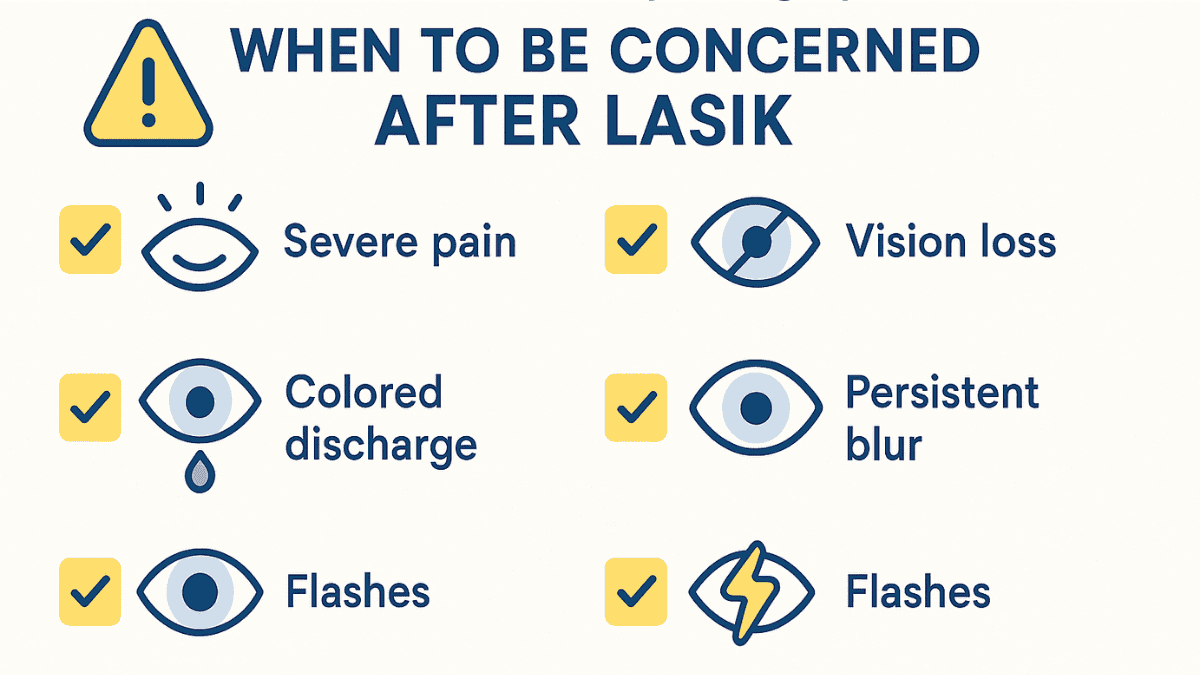
Tips for Managing Blurry Vision During Recovery
To support your healing process and manage blurry vision after your vision correction surgery, consider these tips. Adhering to your surgeon’s instructions is paramount during the LASIK surgery recovery period. These steps can help you achieve clear vision faster:
- Use prescribed eye drops, including antibiotic, steroid, and lubricating drops (artificial tears), consistently and as directed. These help prevent infection, control inflammation, and manage dry eye syndrome.
- Wear sunglasses outdoors to protect your eyes from bright light and UV radiation, which can cause discomfort and potentially hinder healing.
- Avoid rubbing your eyes, as this can dislodge the corneal flap (in early recovery) or cause irritation. Your eye doctor may recommend wearing protective shields, especially at night.
- Get plenty of rest, allowing your body to focus on healing.
- Attend all scheduled follow-up appointments. These visits allow your eye doctor to monitor your healing process and address any concerns promptly.
- Stay hydrated by drinking plenty of water, which can help with overall body function, including tear production.
- Avoid dusty or smoky environments, and refrain from swimming or using hot tubs until your doctor gives approval, to minimize infection risk.
Following these guidelines can contribute to a smoother recovery and better visual outcomes. If you wear a contact lens in the other eye or used to wear contact lenses extensively, be particularly mindful of any dry eye symptoms.
Understanding Fluctuations and Long-Term Vision After LASIK
Most patients achieve excellent vision, often 20/20 or better, after their LASIK eye surgery. However, it’s important to have realistic expectations. Some individuals may still need reading glasses for close objects as they age, a condition known as presbyopia, which LASIK typically does not prevent, as it relates to the aging of the eye’s natural lens, not the cornea.
A study published in the Journal of Cataract & Refractive Surgery found that a high percentage of patients were satisfied with their vision after LASIK. Remember, individual results can vary based on factors like pre-operative refractive error, age, and individual healing patterns. Even if your distance vision is perfect, your near vision might change over time.
It is also important to consider how systemic health can affect vision. For instance, fluctuating blood sugars can impact vision clarity even in eyes that have not had surgery. If you have diabetes, maintaining stable blood sugar levels is important for consistent vision after LASIK, as high sugar levels can cause temporary swelling of the eye’s lens, leading to blurred vision that’s responsible for changes in prescription.
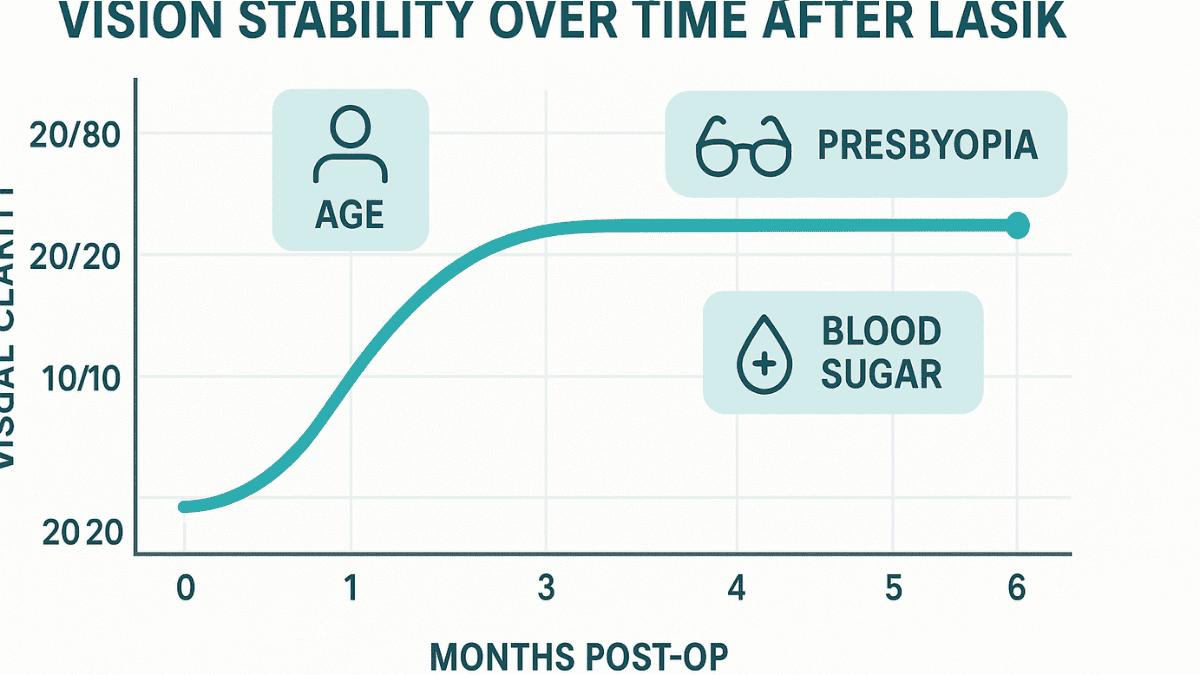
Enhancing Your Vision After LASIK
If, after several months (typically 3-6 months), your vision has stabilized but you are not satisfied with the outcome, or if there is a significant residual refractive error causing blurry vision, discuss this with your surgeon. They will perform a thorough eye exam to determine the cause. Depending on the findings, they may recommend several options:
- Continued use of specific eye drops or medications, especially if dry eye syndrome is a contributing factor.
- Vision exercises, though these are less common for addressing post-LASIK blur.
- A LASIK enhancement procedure or additional surgery. This is a secondary laser treatment to further refine the corneal shape.
Enhancement procedures, a form of correction surgery, are generally only considered after your vision and corneal measurements are stable. The decision to proceed with an enhancement involves careful consideration of the potential benefits and risks. Sometimes, for very minor errors, patients opt for thin glasses for specific tasks rather than another laser eye procedure.
Related Article
LASIK Eye Surgery: What You Need to Know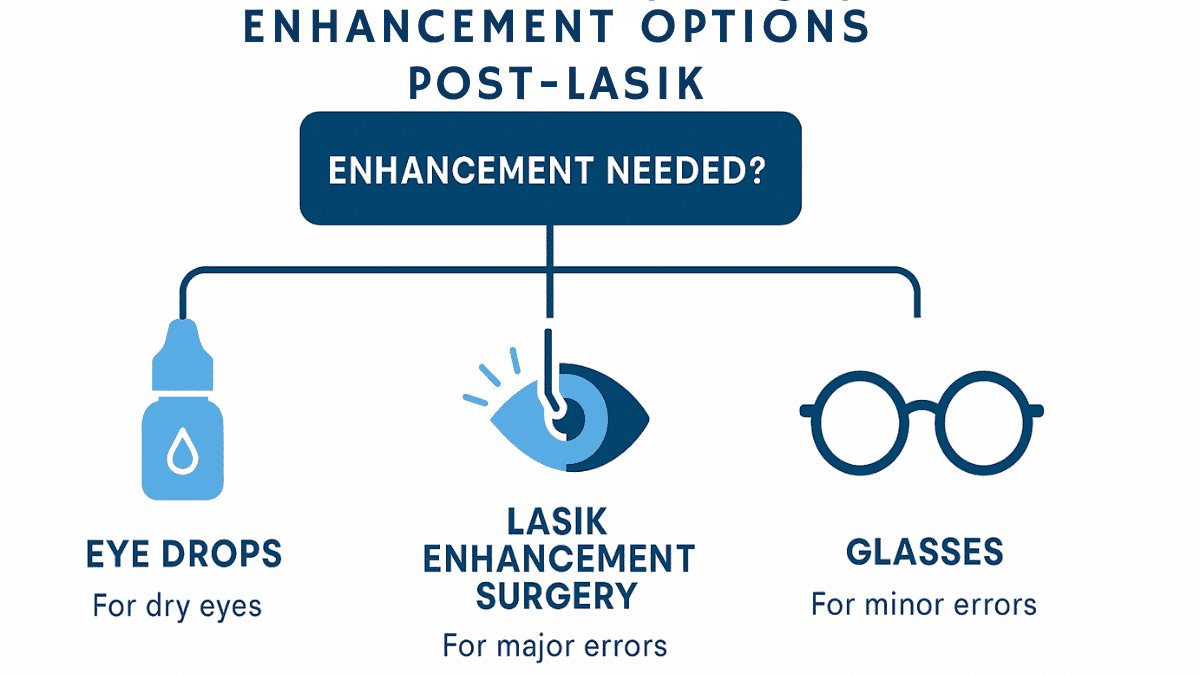
Preventing Vision Issues and Promoting Optimal Healing After LASIK
While some temporary blurry vision normal occurrences are part of the recovery time, you can take steps to promote optimal healing and reduce the risk of prolonged vision issues. Choosing the right surgeon and following instructions are key. Proper eye care is essential both before and after the surgery.
- Select an experienced LASIK surgeon with a strong track record. Look for a surgeon who uses advanced technology, like a femtosecond laser for flap creation, if applicable.
- Follow all pre-operative and post-operative instructions meticulously. This includes medication schedules and activity restrictions.
- Maintain good overall health. A healthy body supports better healing. Conditions like uncontrolled diabetes or autoimmune diseases can affect healing.
- Protect your eyes from injury by wearing safety glasses during risky activities and from excessive UV damage by consistently wearing sunglasses.
- Discuss any pre-existing eye conditions, like a history of severe dry eye or very thin corneas, with your doctor during your initial consultation. This helps determine if you are a good candidate for LASIK or if another type of vision correction surgery, like lens replacement or refractive lens exchange, might be more suitable, especially if cataract surgery might be needed later in life.
These measures can help reduce your risk of complications and support your journey toward clear vision. Understanding that the cornea’s outer layer needs time to heal smoothly is important for patience during recovery.
Related Article
Is Laser Eye Surgery Worth It? Exploring the Benefits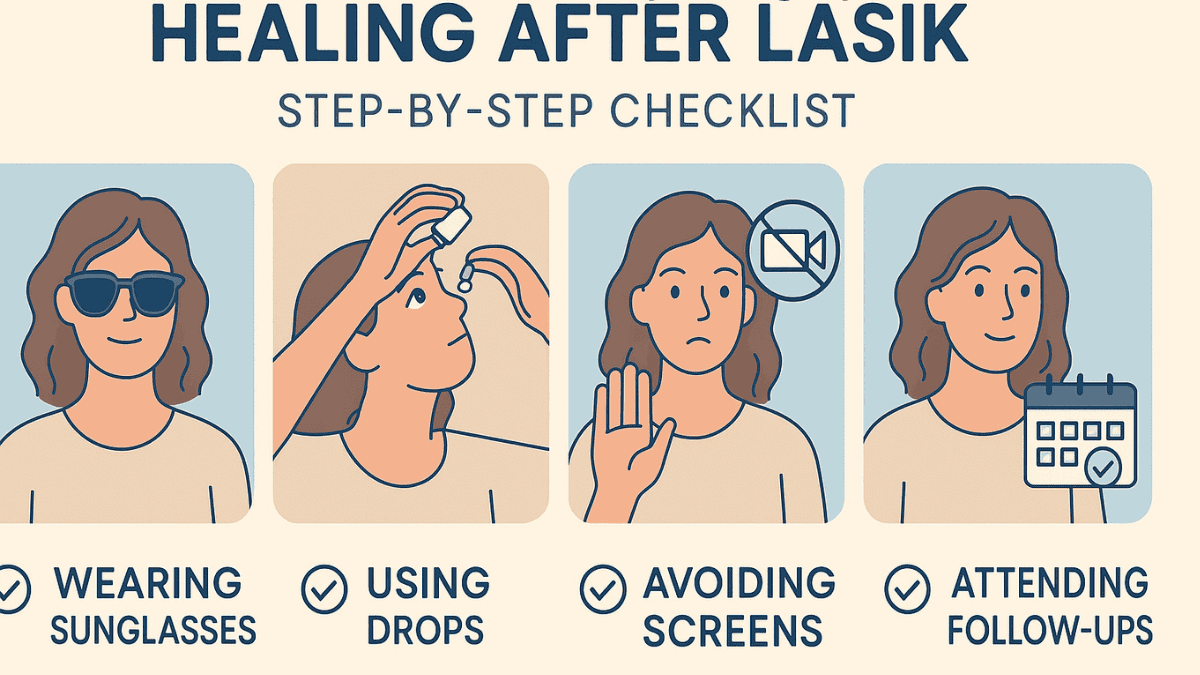
The Role of Regular Eye Check-ups Post-LASIK
Even after your initial recovery period for the LASIK surgery is complete and your vision seems stable, regular eye exams are crucial. These appointments allow your eye doctor to monitor your long-term vision and overall eye health. They can detect any subtle changes or late-onset complications.
Annual eye exams are recommended to check for any changes in your refractive error and to screen for other eye conditions unrelated to LASIK, such as glaucoma, macular degeneration, or issues with the retina. While LASIK corrects the cornea’s shape, it doesn’t prevent age-related eye changes or other eye diseases. Maintaining routine eye care ensures your eyes corrected by LASIK continue to function optimally.
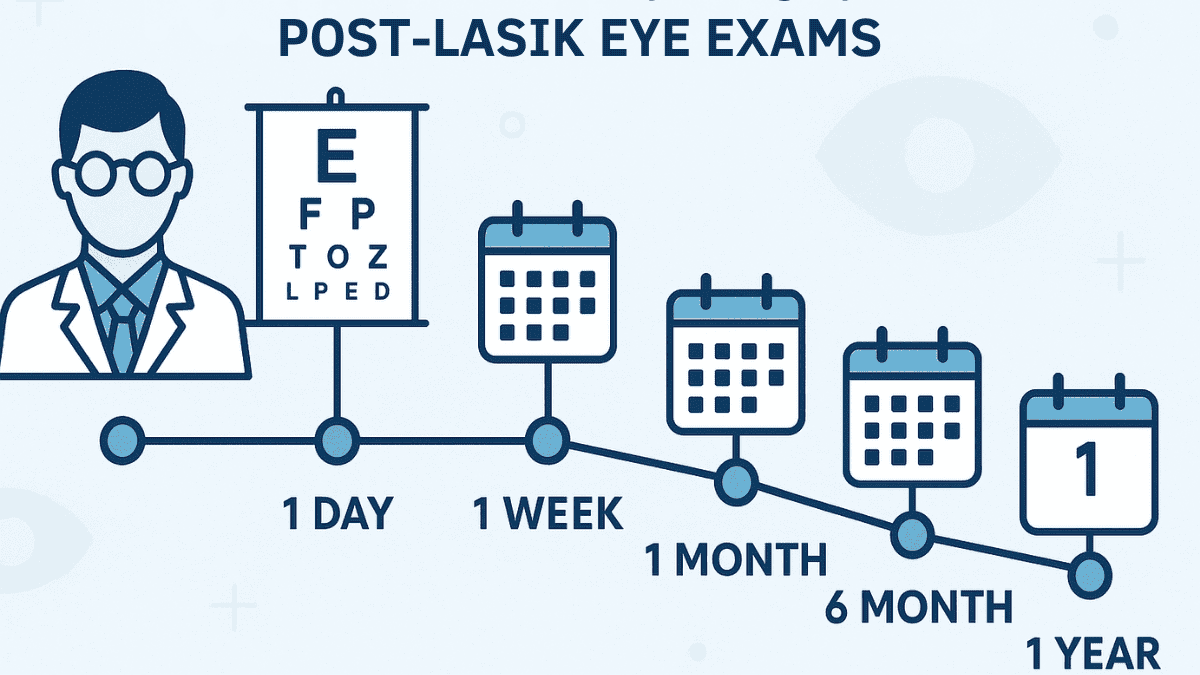
Understanding Potential LASIK Complications Beyond Blurriness
While serious complications from laser vision correction are rare, it’s good to be aware of them. Most instances of blurry vision are temporary, but other issues can sometimes arise. Your eye surgeon will discuss these with you before you decide on undergoing LASIK.
Potential complications can include:
- Persistent dry eye syndrome: While often temporary, some individuals may experience chronic dry eyes that require ongoing management with artificial tears, prescription eye drops, or punctal plugs.
- Under-correction, over-correction, or induced astigmatism: This means your vision isn’t as sharp as desired, potentially requiring glasses, contact lenses, or an enhancement procedure. Residual myopia post-operatively is an example of under-correction for nearsightedness.
- Night vision problems: Some patients report glare, halos around lights, or starbursts, particularly at night. These symptoms often improve over several months but can be persistent for a few.
- Flap-related complications (for LASIK procedures creating a flap): Issues like flap displacement, wrinkles, or inflammation under the flap (diffuse lamellar keratitis) are uncommon but require prompt medical attention.
- Corneal ectasia: A very rare but serious condition where the cornea progressively thins and bulges outward, causing worsening vision. Pre-operative screening helps identify those at higher risk.
If you have concerns about these potential complications from the eye surgery, discuss them thoroughly with your eye doctor. Understanding the risks and benefits is key to making an informed decision about LASIK eye surgery or other forms of lens surgery or laser cataract surgery if those are being considered for different reasons.
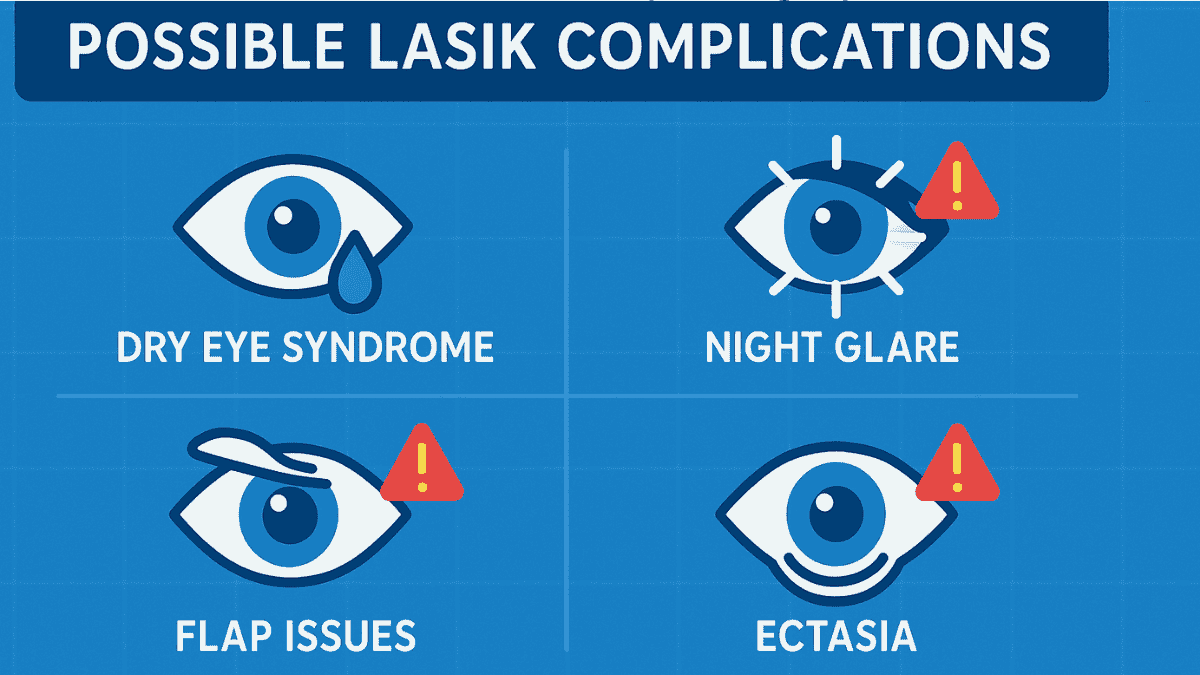
The Importance of Patience and Communication During LASIK Recovery
Achieving your best possible vision after LASIK takes time and patience. It’s natural to feel anxious if you experience blurry vision, but remember that healing is a gradual process. Most patients see significant improvement in their vision within the first month, with vision continuing to refine and stabilize over several months, sometimes up to six months or longer for full stability.
Stay in close communication with your eye care team throughout your surgery recovery. They can provide reassurance, answer your questions, and address any concerns you may have about your healing process or vision changes. Regular follow-ups allow them to monitor your progress and ensure everything is healing as expected after your laser eye treatment.
Related Article
Does LASIK Make Your Eyes Look Bigger? Exploring the Perception
Conclusion
Blurry vision after LASIK is a normal and expected part of the healing process for many patients. Understanding the typical recovery timeline, including the initial phase of blurred vision, can help ease anxiety and set realistic expectations for your vision correction journey. While most blurriness resolves within a few weeks to months, leading to clear vision, it’s important to stay vigilant and report any concerning symptoms to your eye doctor promptly.
Remember, LASIK, a type of refractive surgery, has a high success rate, with most patients achieving excellent vision and reduced dependence on glasses or contact lenses. With patience, adherence to post-operative eye care, and regular follow-up appointments, you are likely to enjoy the benefits of your vision correction surgery. Your path to better sight is an ongoing process, and careful management of the recovery time is vital.
FAQ
Yes, mild to moderate blurry vision during the first week is expected as the cornea heals and the tear film stabilizes. It usually improves gradually day by day.
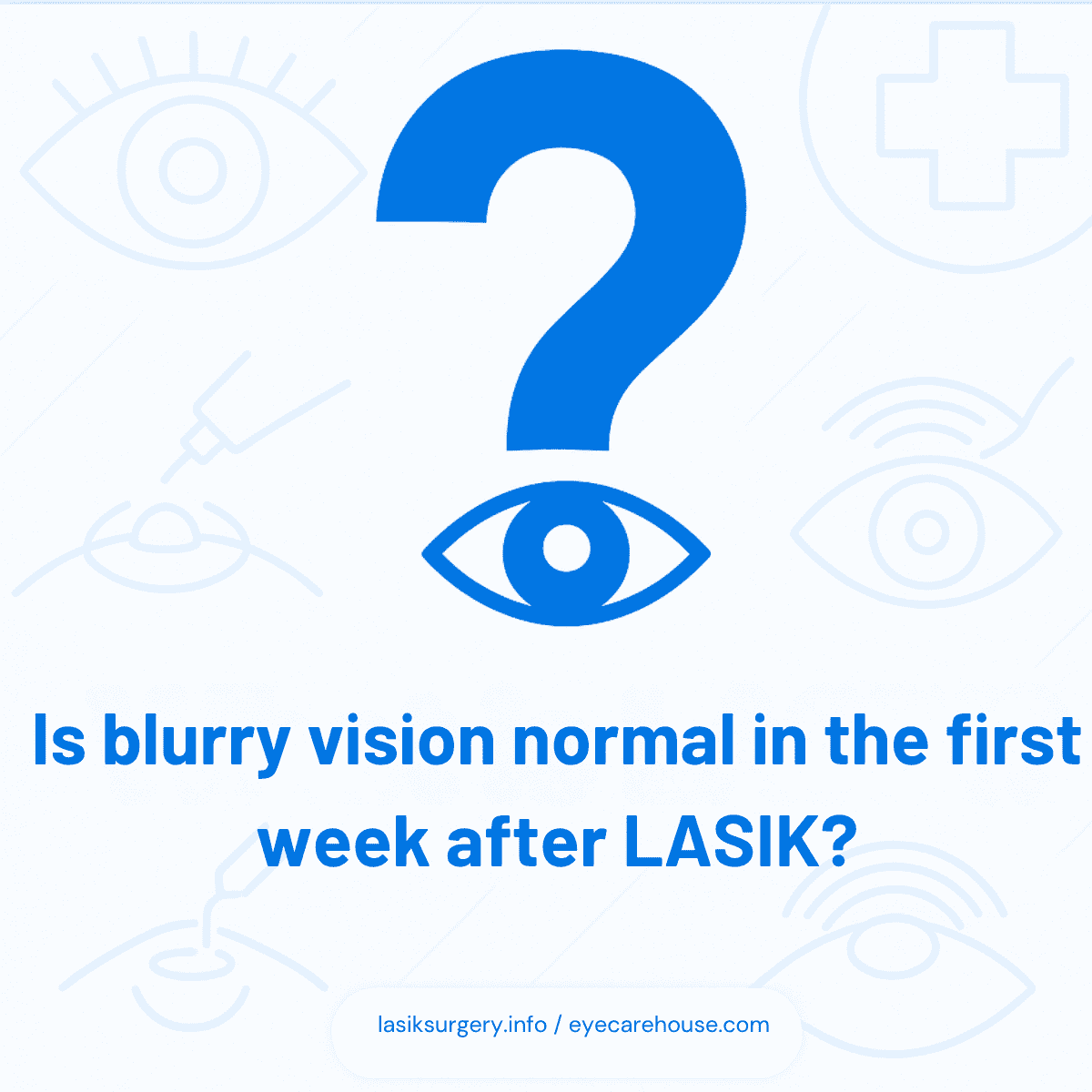
Fluctuating vision is often due to post-LASIK dry eyes or changes in tear film quality, especially in the first few weeks. It’s common and typically resolves with time and lubrication.
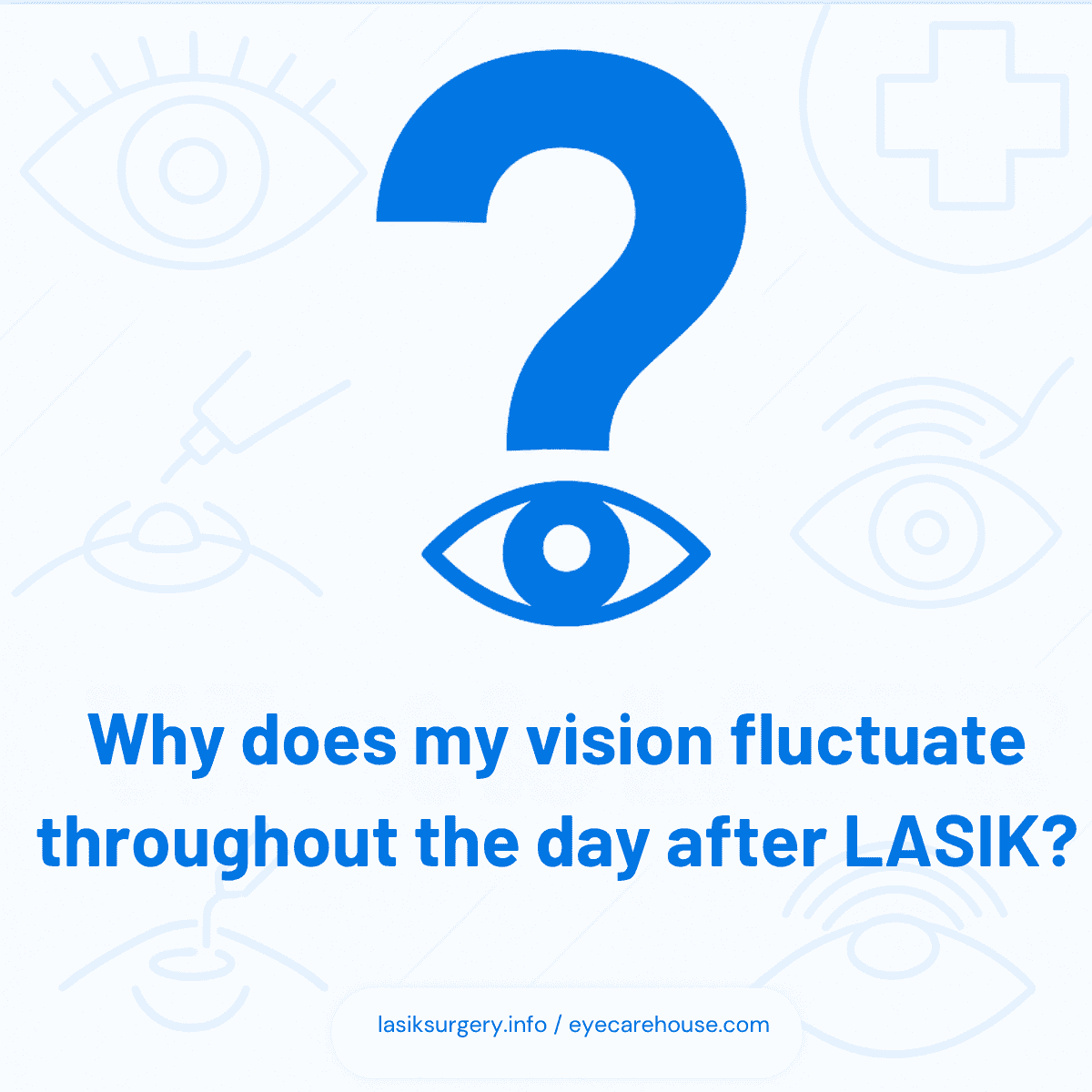
For most patients, noticeable improvement occurs within the first month. However, minor blurriness or fluctuations can persist for up to 3 months depending on healing patterns.
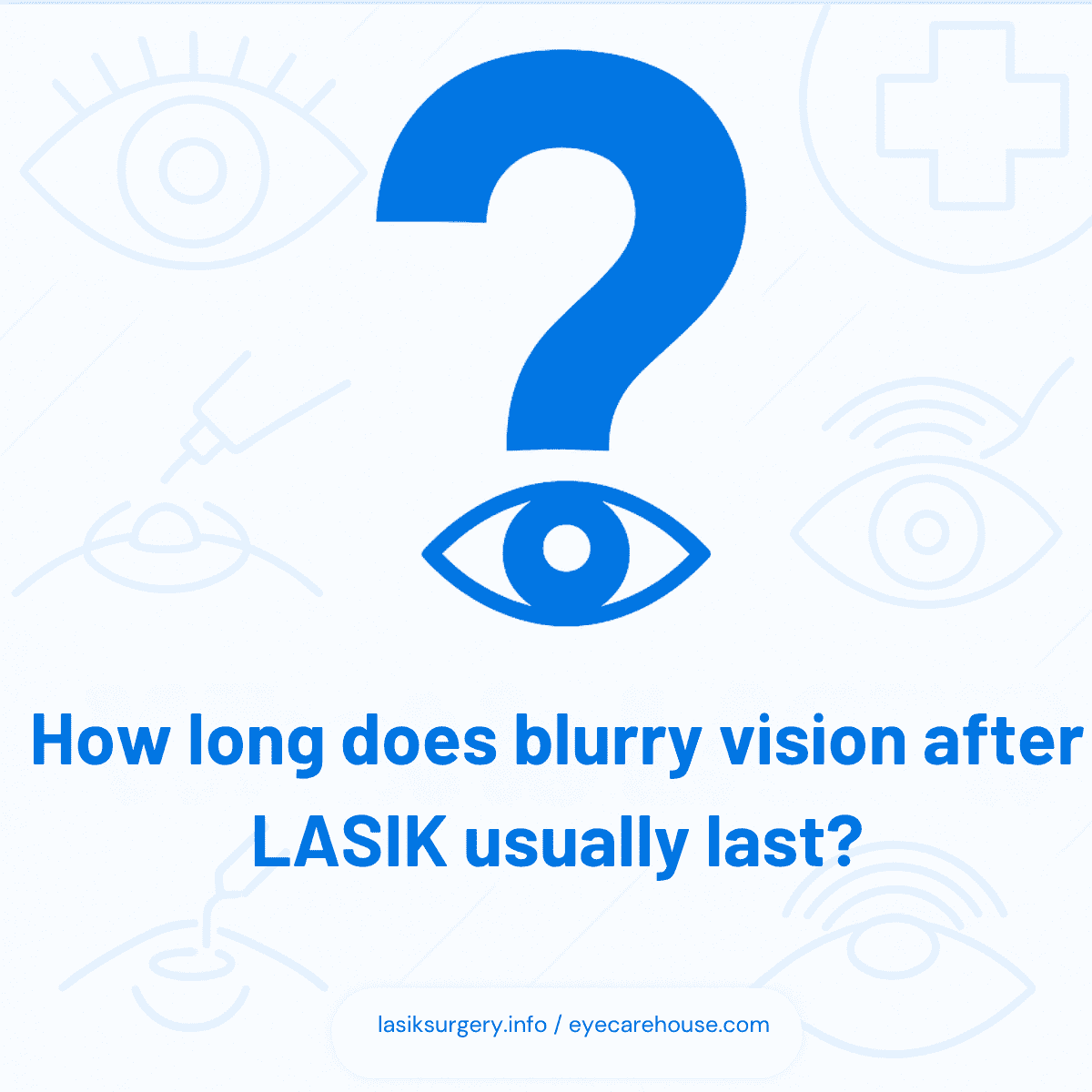
Yes, it’s possible for one eye to heal slightly slower than the other. Asymmetrical healing can result in temporary blurriness in one eye, but this typically balances out.
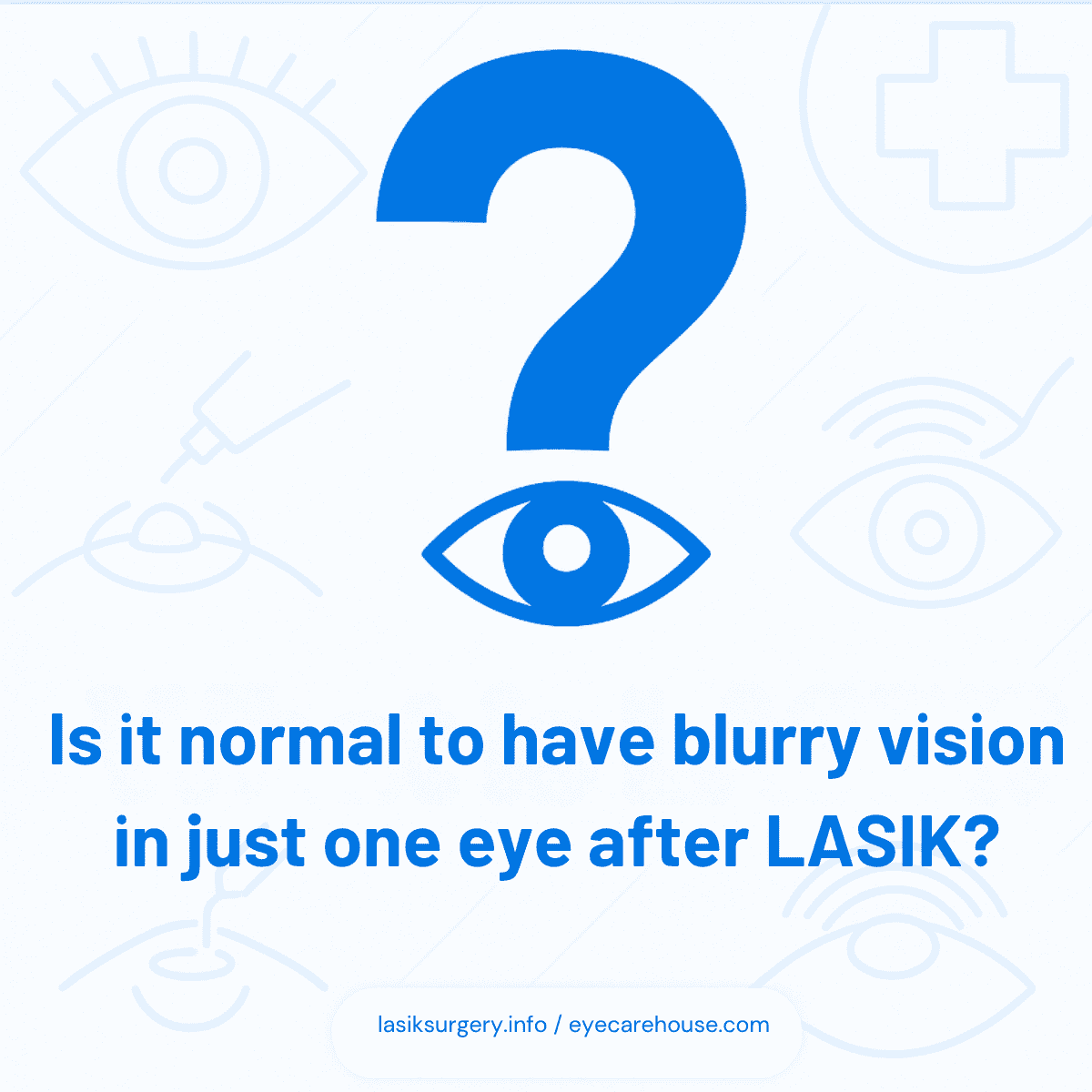
Absolutely. Dry eye is one of the most common causes of post-LASIK blurry vision. Managing tear film stability is essential for clear and comfortable sight during recovery.
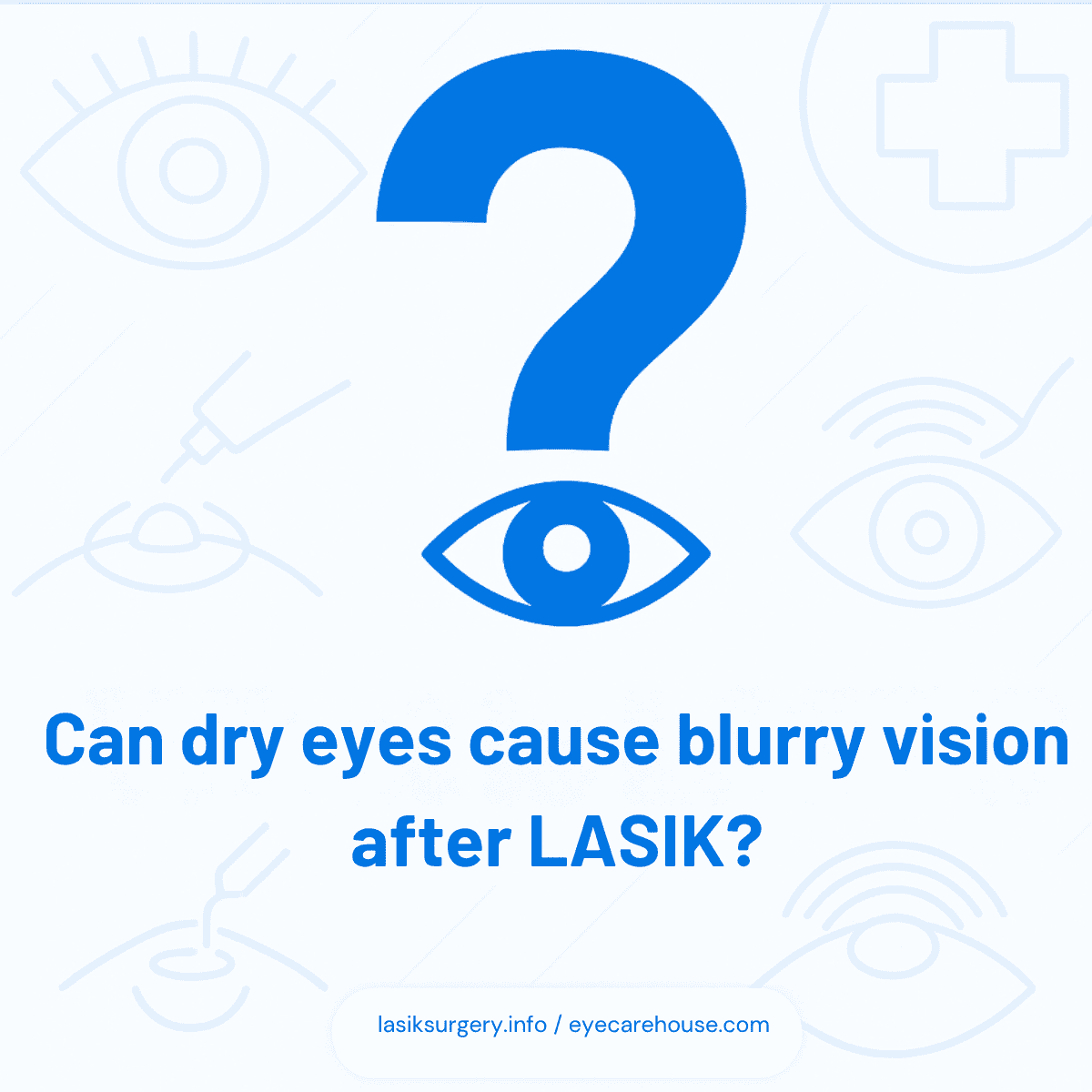
Not necessarily. Blurry vision is a normal part of the healing curve. However, if the blurriness worsens or doesn’t improve within a few weeks, it’s worth checking with your surgeon.
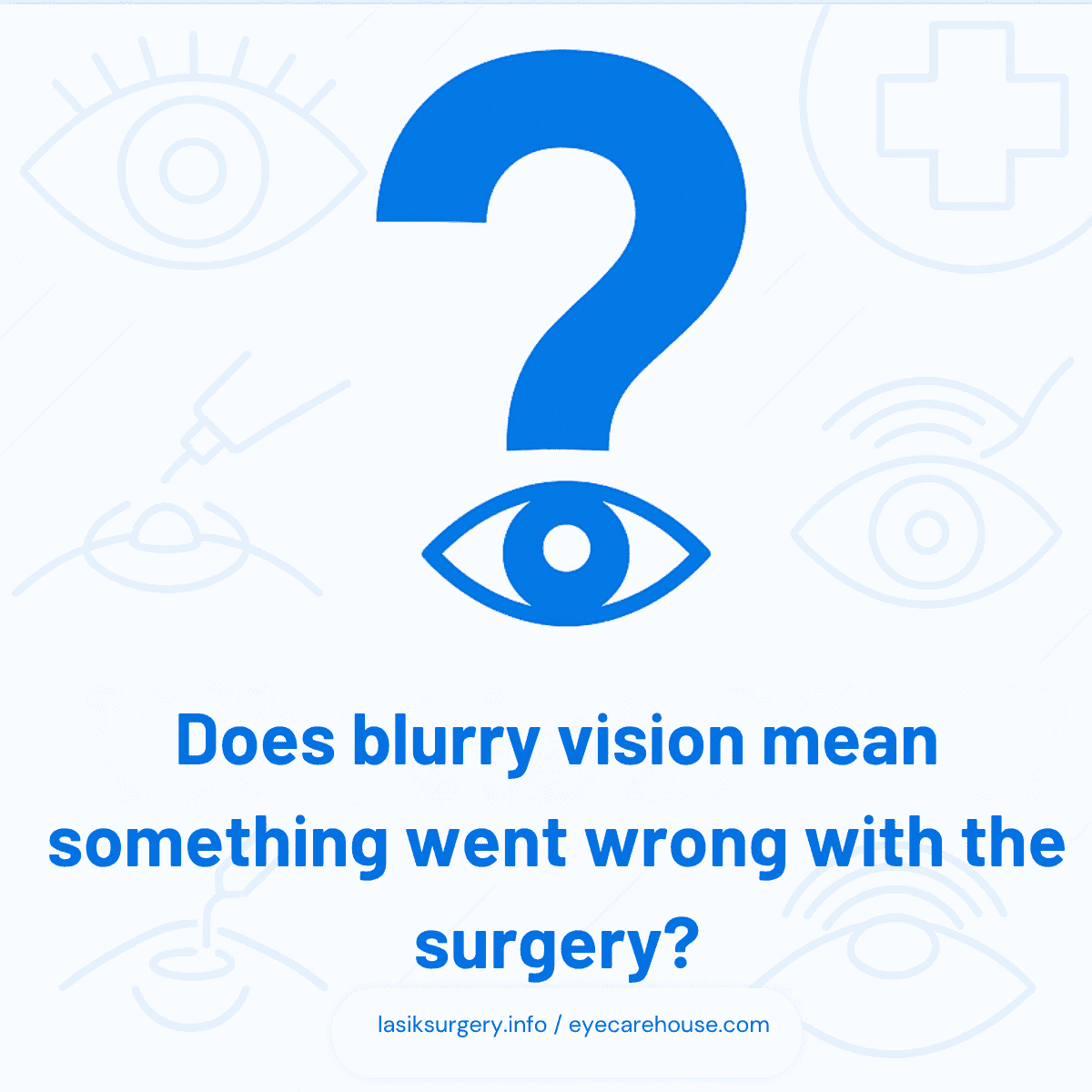
Yes. A small degree of under- or over-correction may remain, causing mild blurriness. This is usually monitored over time and, if needed, corrected with a LASIK enhancement.
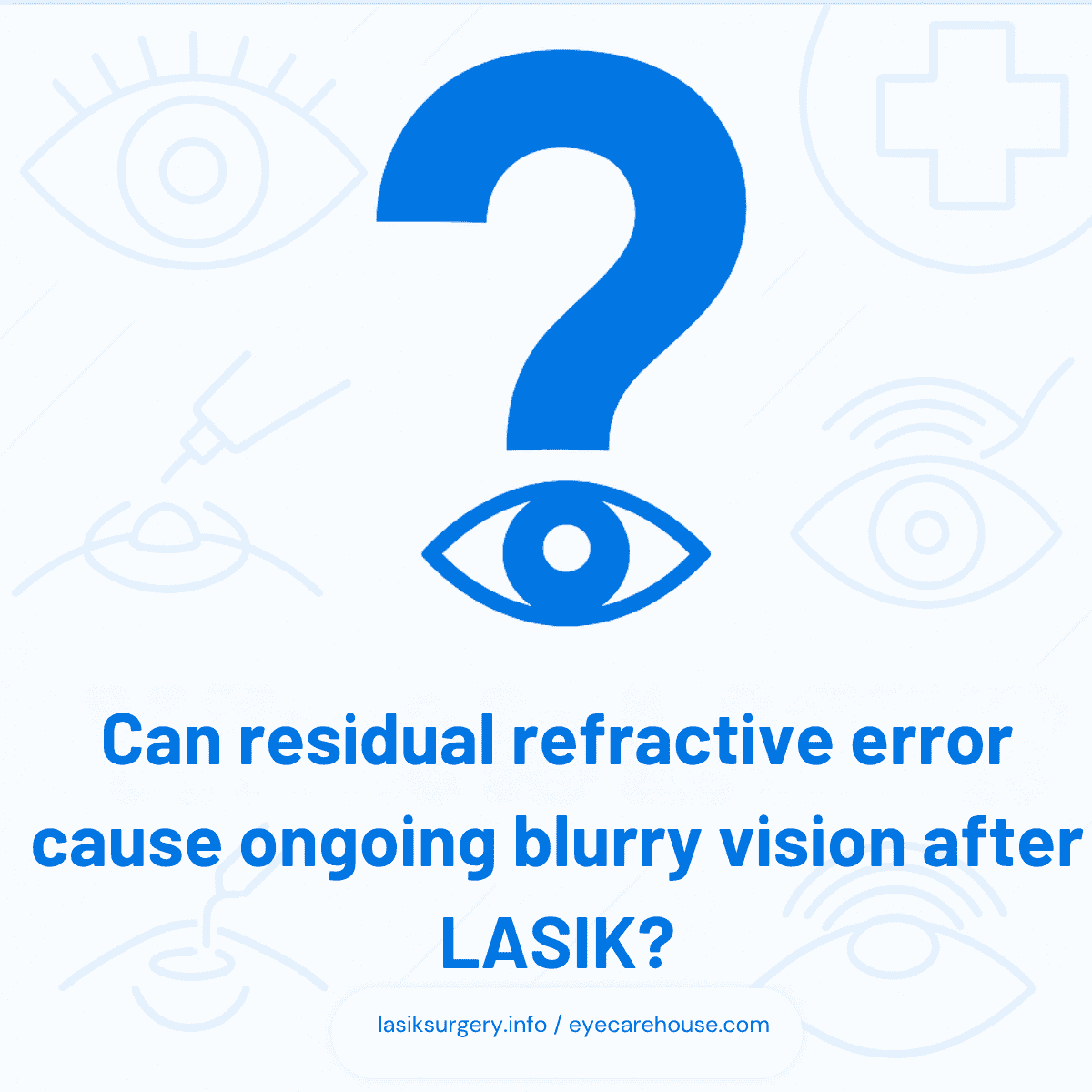
Nighttime blurriness or glare is common early in recovery due to pupil dilation, dry eyes, or healing of the corneal surface. It generally improves as healing progresses.
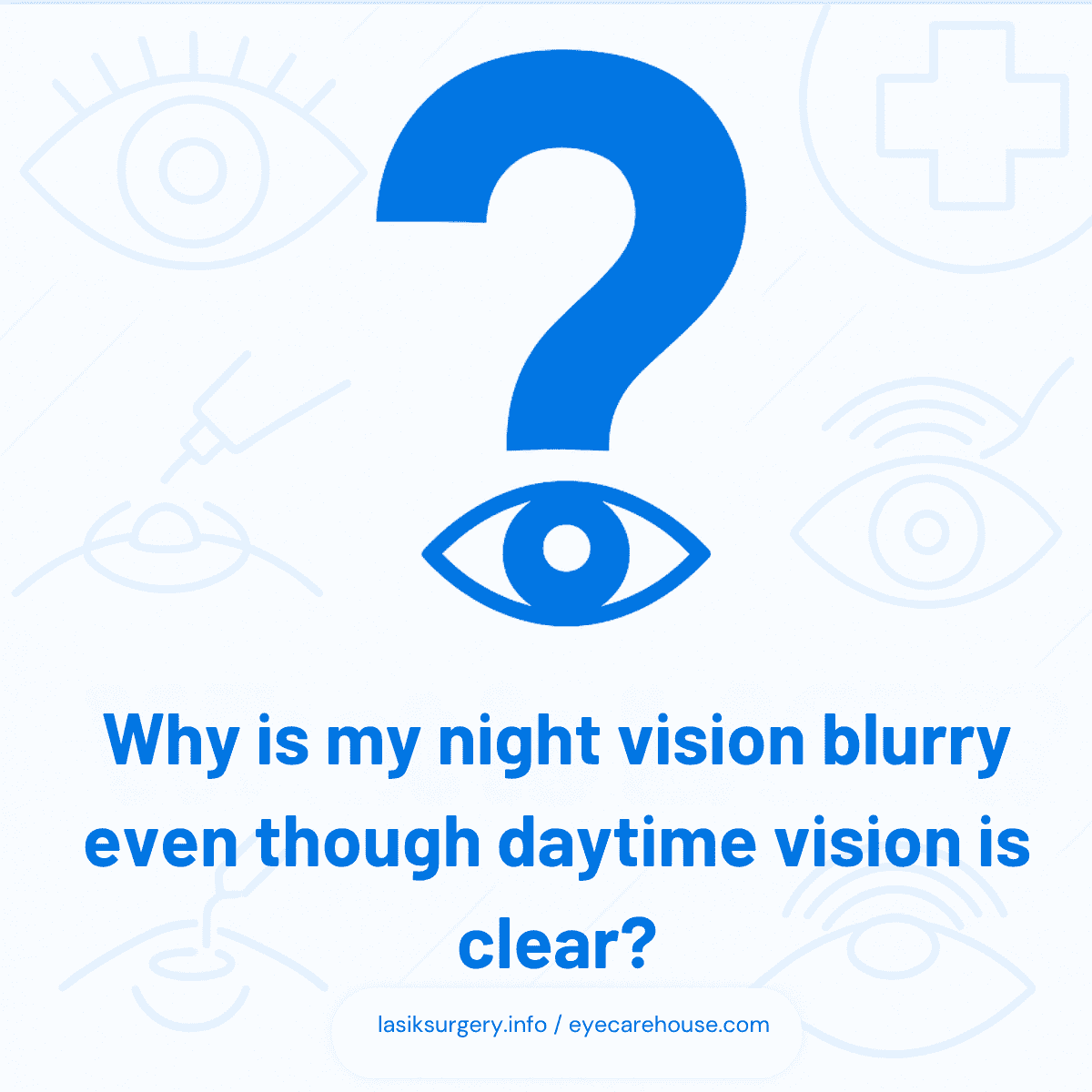
Yes, extended screen use can exacerbate dry eyes, leading to temporary increases in blurry vision. Taking breaks and using artificial tears can help manage symptoms.
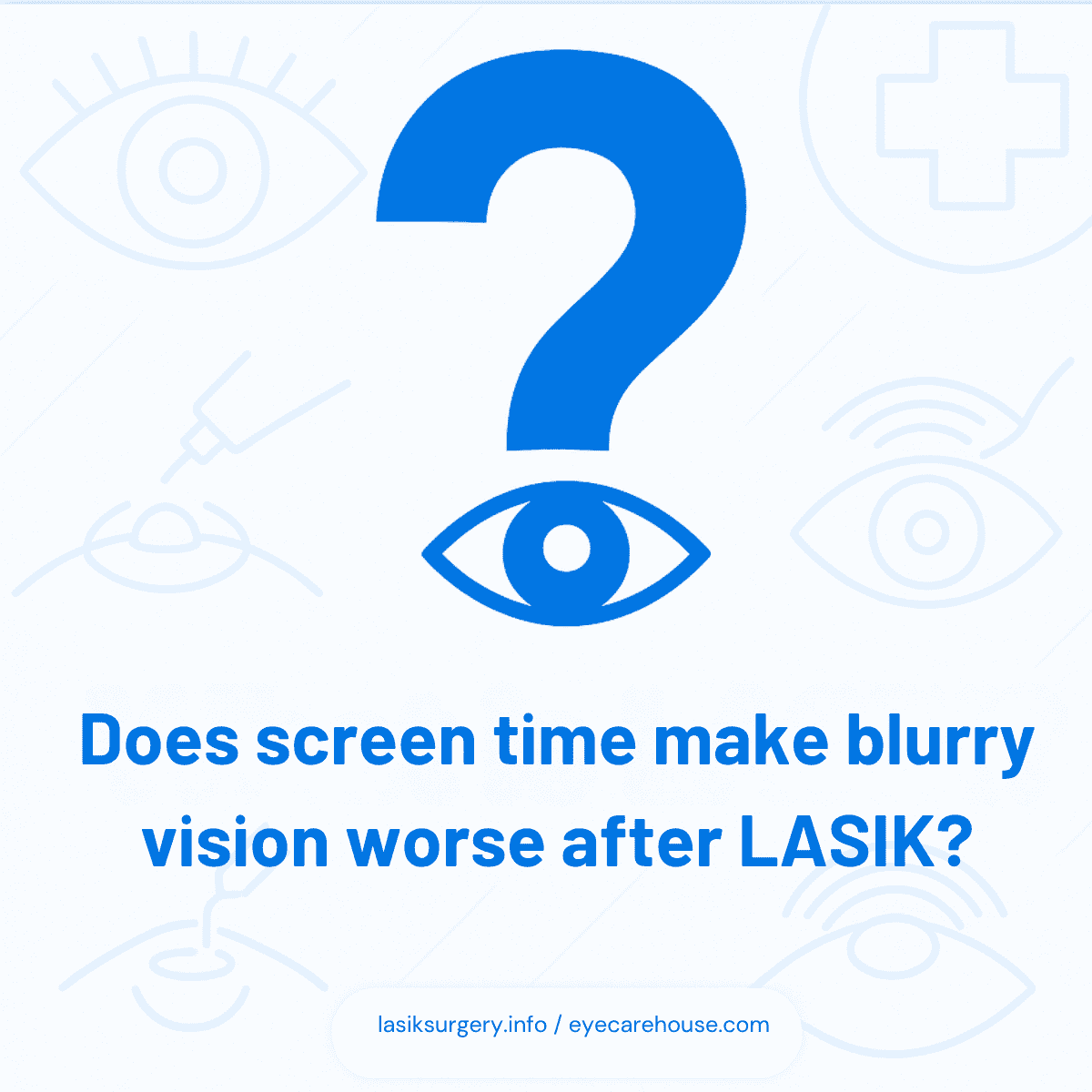
If blurry vision lasts beyond 3–6 months, worsens suddenly, or is accompanied by pain, redness, or discharge, you should contact your eye doctor immediately.
